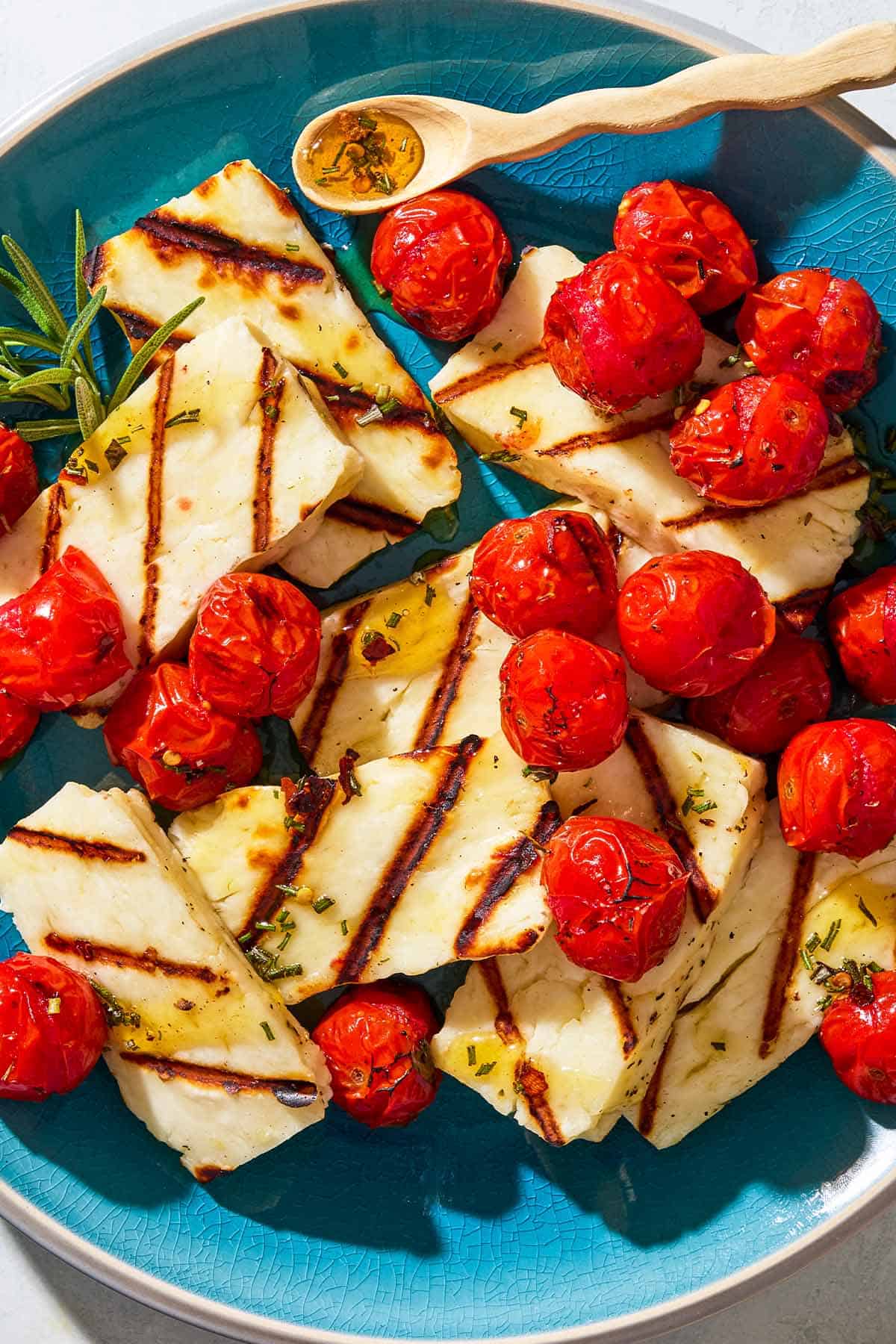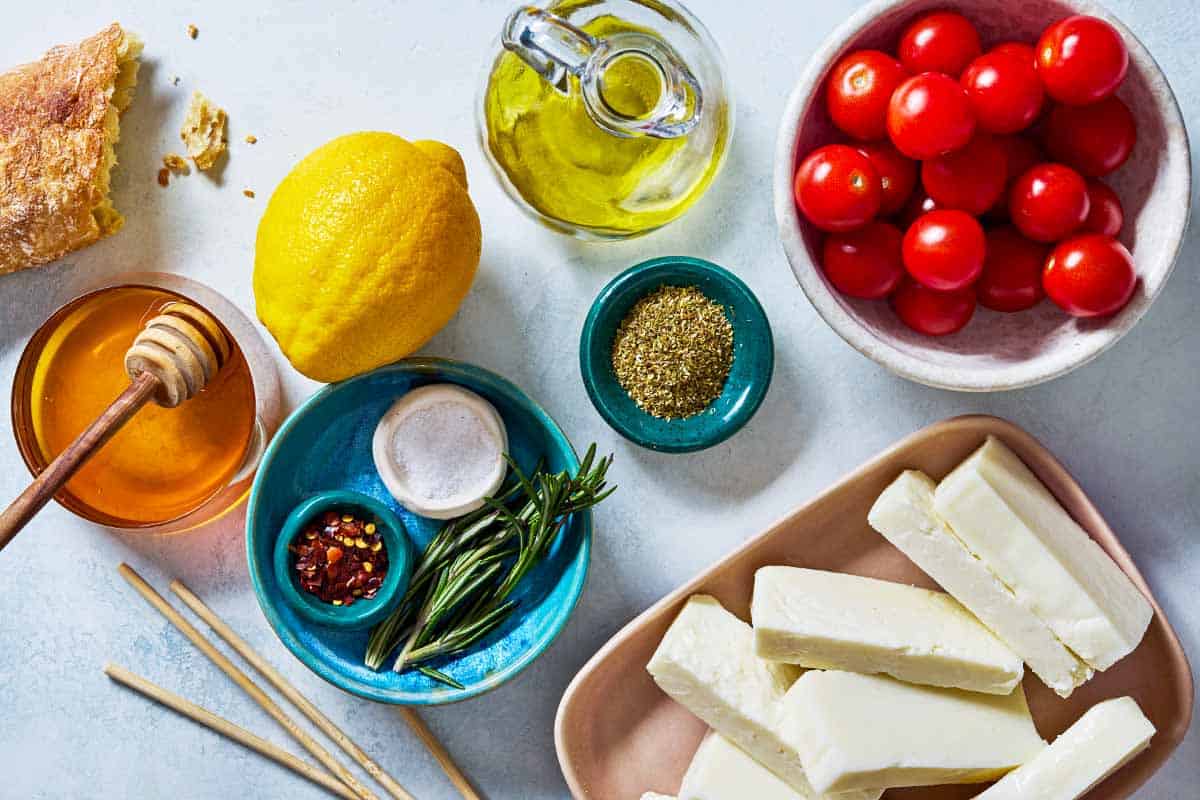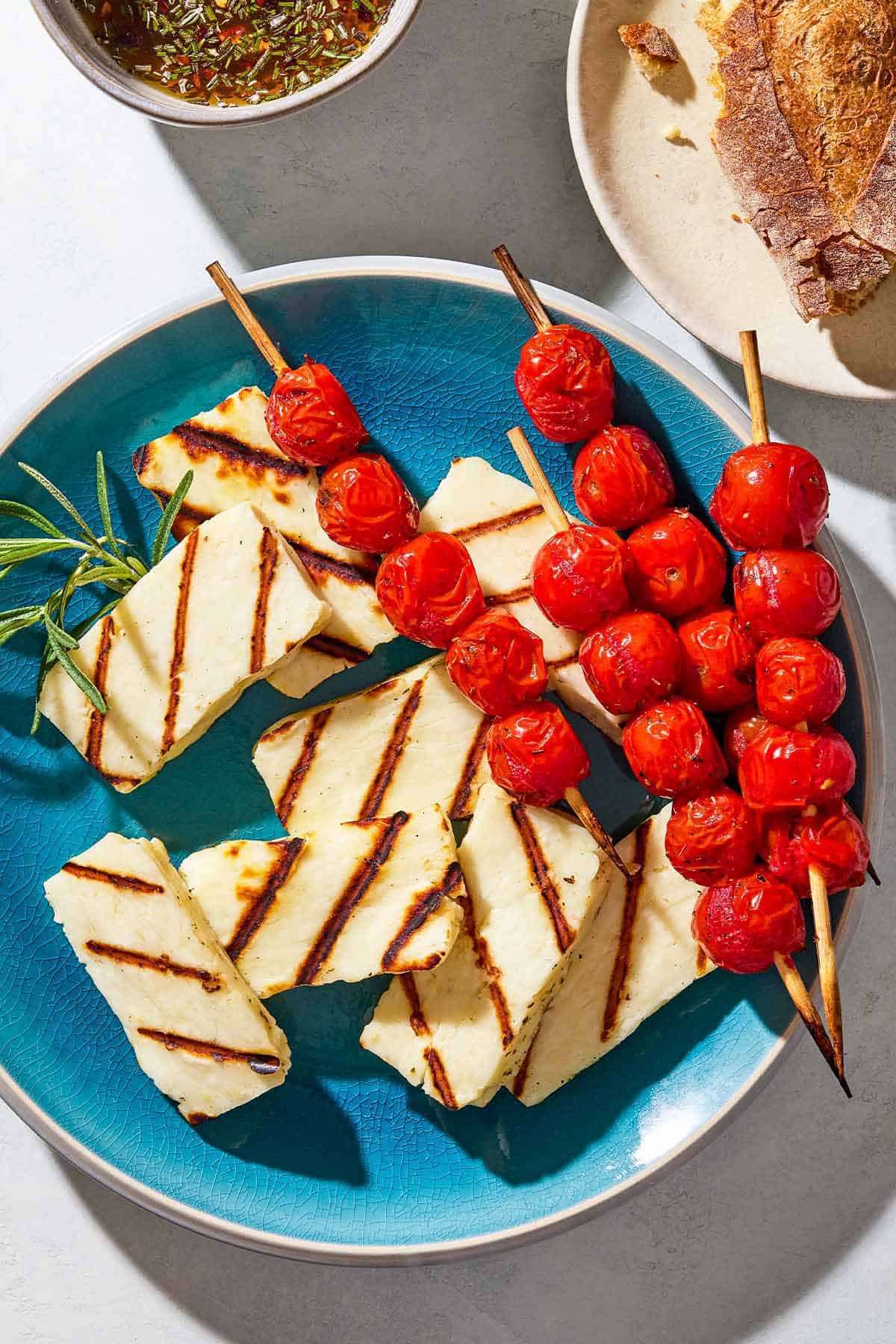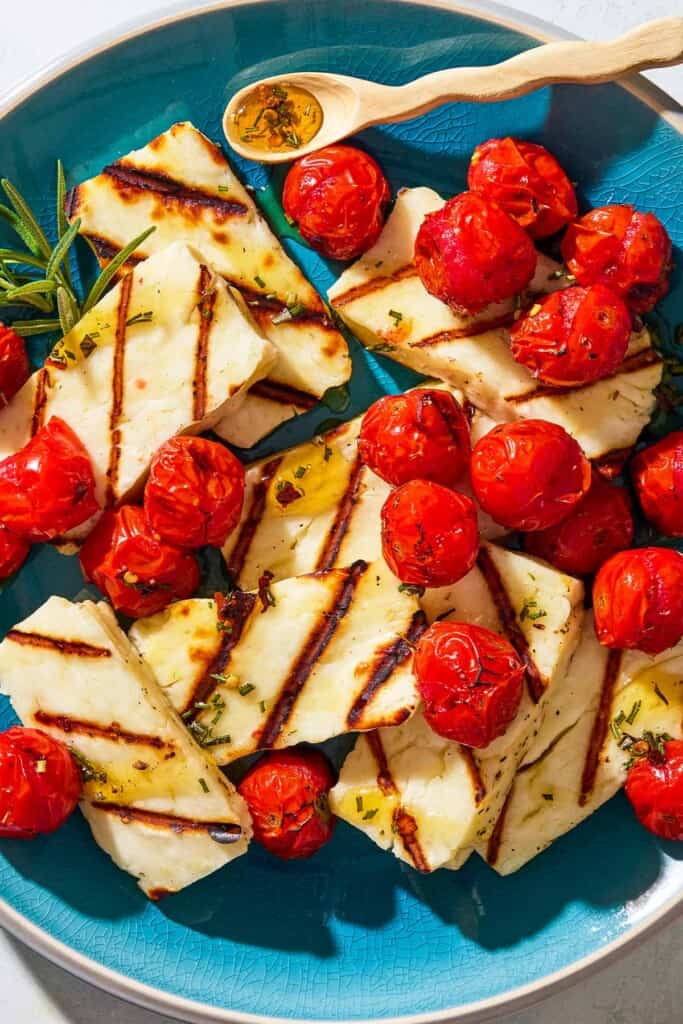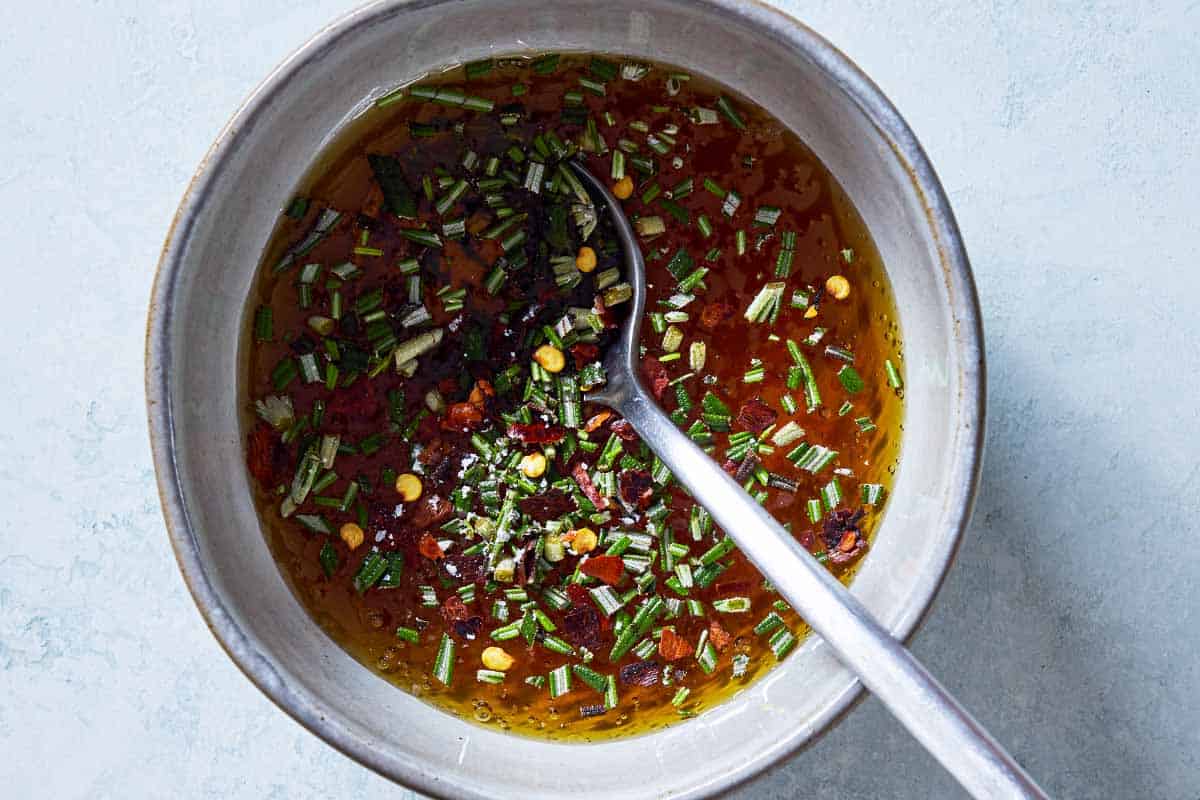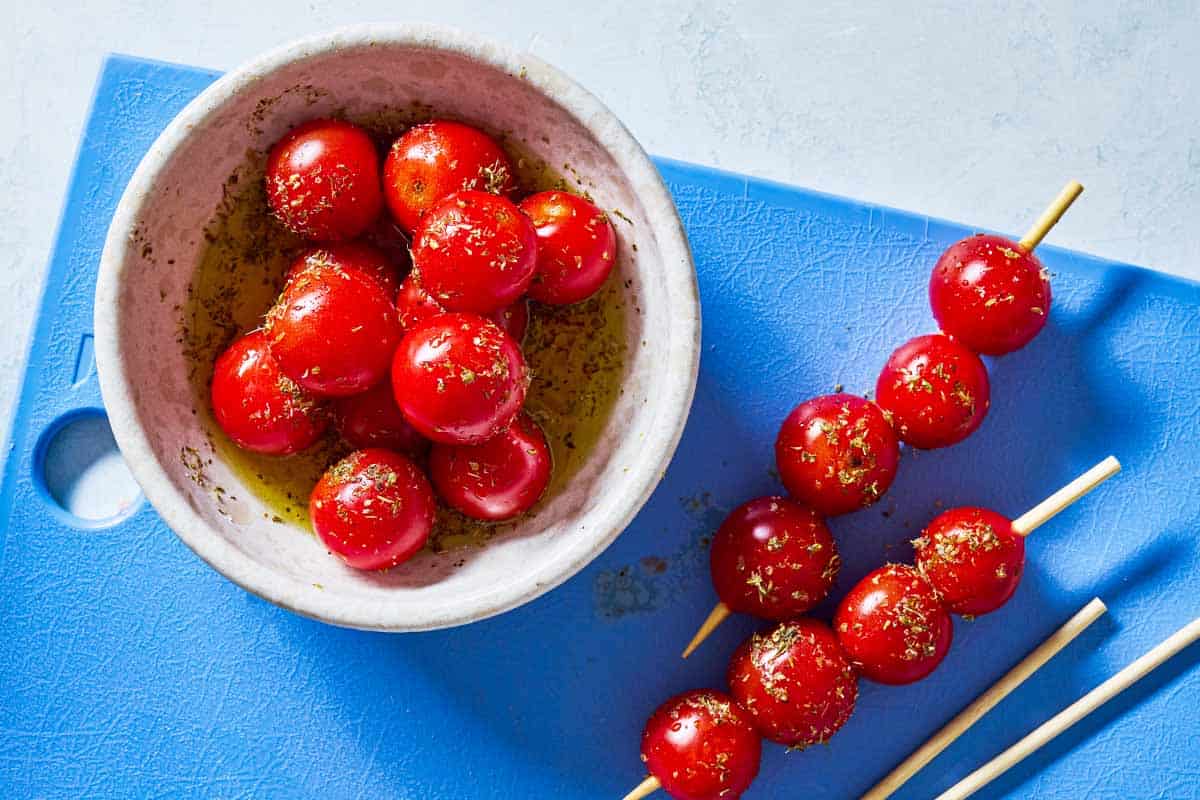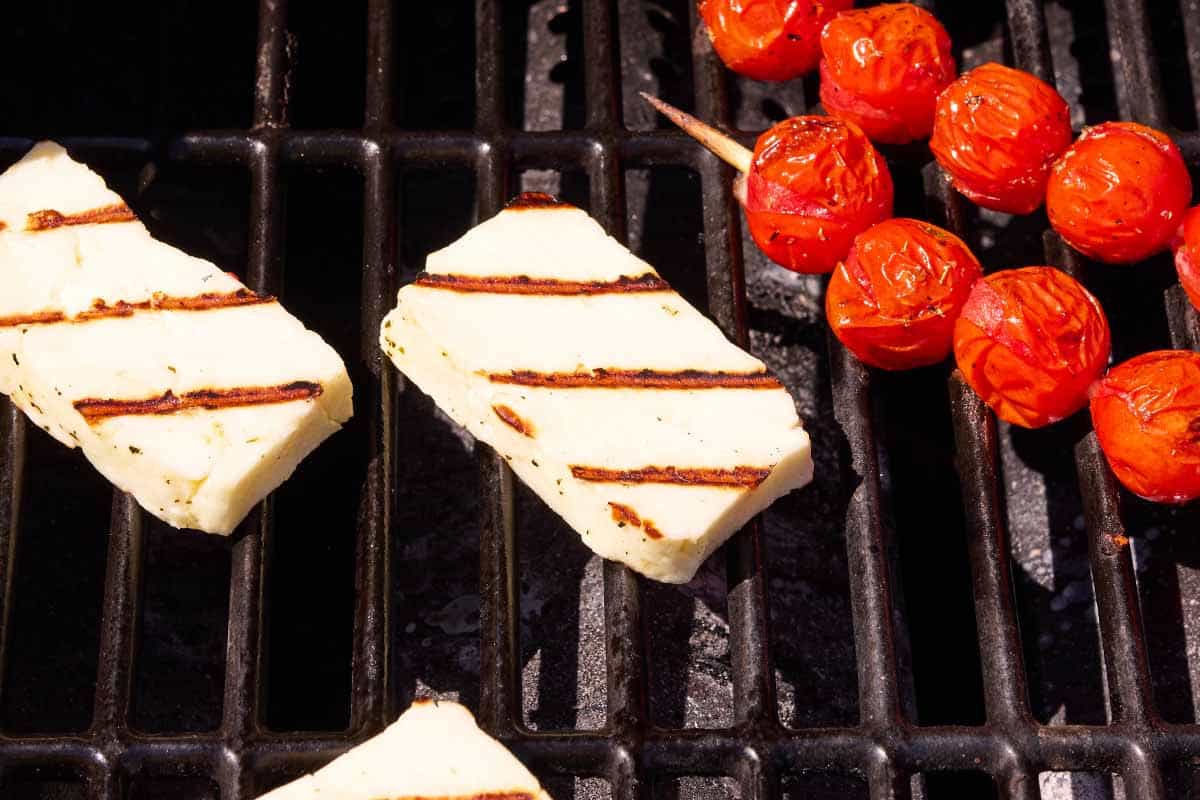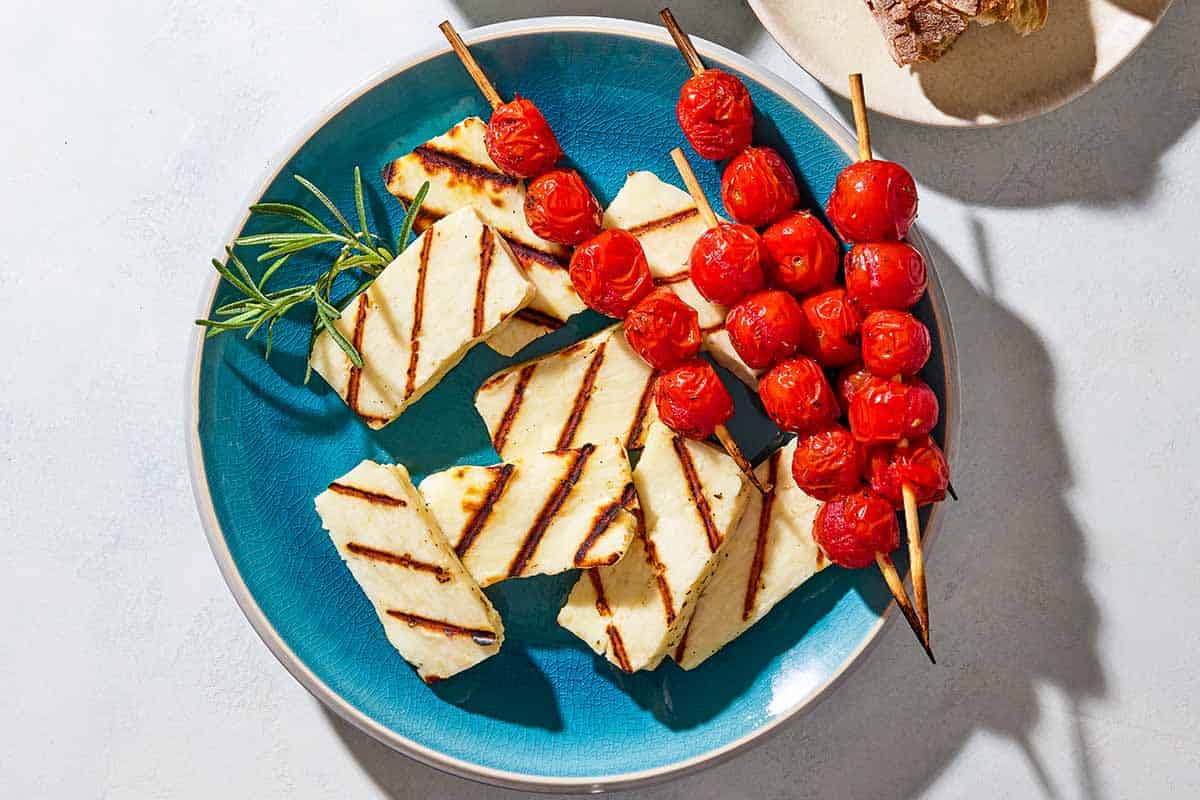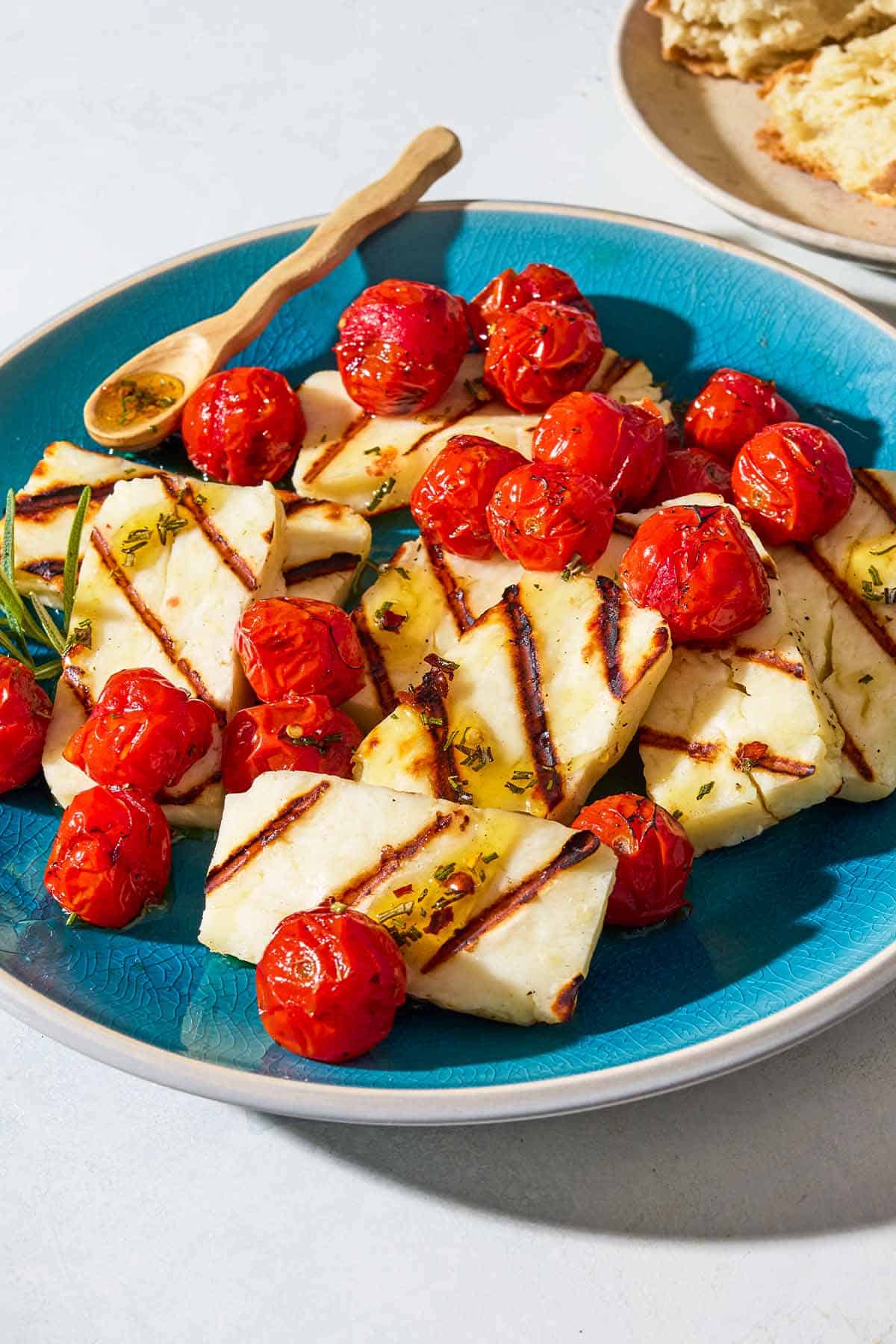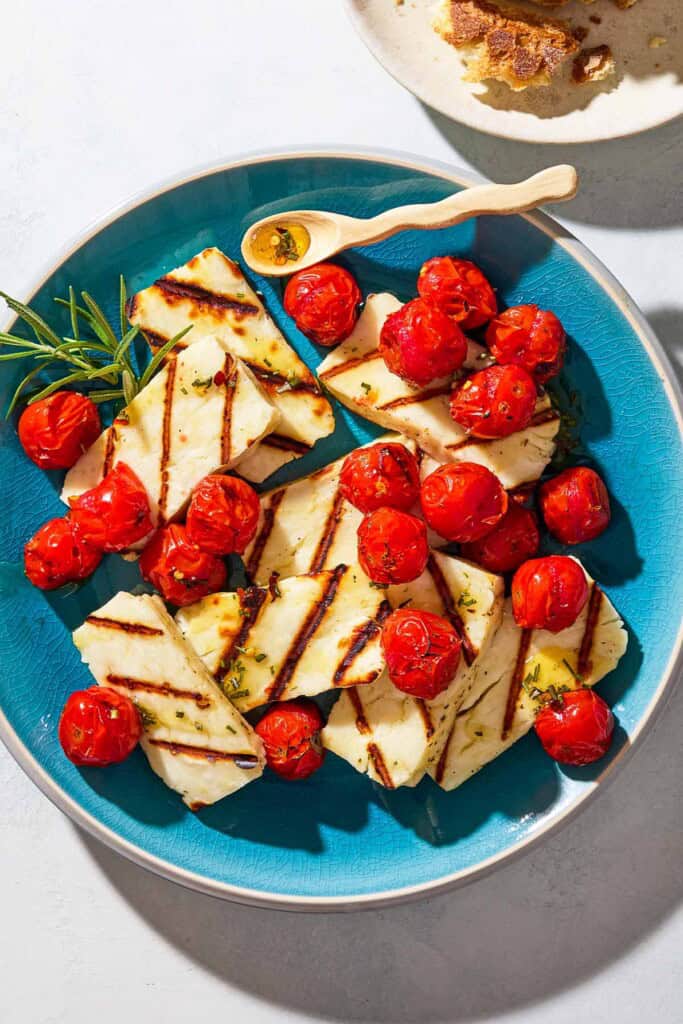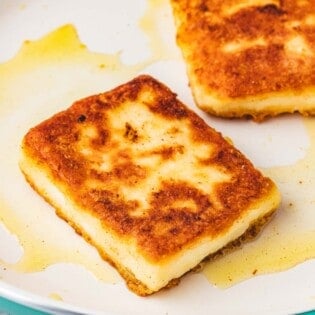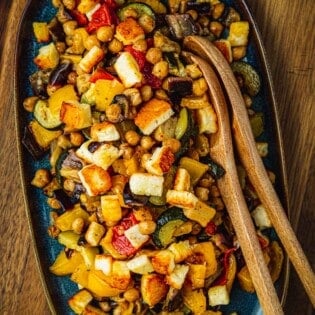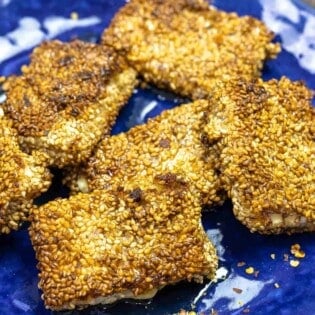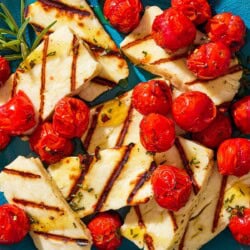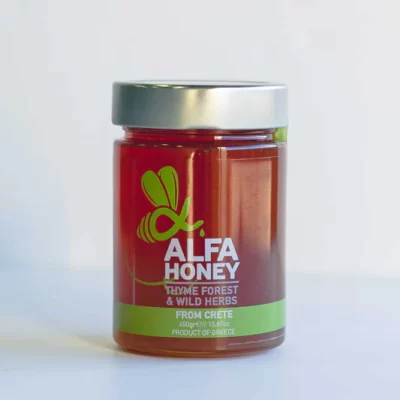Are you curious how to grill cheese without it melting through the grill grates? Let me introduce you to halloumi! Halloumi does not melt, and has a sturdy, chewy texture with a mild salty flavor. Cooking this Cypriot cheese—whether you’re making grilled halloumi or pan-fried halloumi—makes it crispy on the outside and deliciously gooey on the inside. This grilled halloumi recipe is delicious on its own, but adding rosemary-infused honey and an acidic bite from blistered tomatoes perfectly balances the saltiness with a sweet and savory note to make it even more scrumptious. Serve at your next dinner or outdoor grilling party, or enjoy with your family as a midweek pick-me-up along with a summer salad. It’s a crowd-pleaser, so double the recipe because it will disappear in no time!
Grilled Halloumi Ingredients
To make grilled halloumi cheese, you only need the cheese, oil, and a hot grill. But I like to balance the flavor with spice, aromatics, and sweetness. You’ll need:
Halloumi cheese: You can purchase Halloumi in most grocery stores; however, a Mediterranean deli or Middle Eastern market almost always stocks it. Look for halloumi cheese from sheep and goat milk if you want the real deal. Keep the cheese refrigerated in its original wrapper, which contains some brine. Once you have opened the cheese, tightly wrap it, and use it within 5-7 days. Extra virgin olive oil: Flavors the cheese and tomatoes and prevents them from sticking to the grill. I always opt for an excellent extra virgin olive oil that is robust and peppery in flavor, like our Spanish Hojiblanca. Cherry tomatoes: The perfect sweet and bright complement to salty halloumi cheese. They blister and char on a grill, releasing a candied sweetness. You could use green or yellow cherry tomatoes if you prefer. Oregano: I always like to add dried oregano for its unique flavor, which combines subtle notes of sweetness, pepperiness, and bitterness. Stock up on high-quality Greek oregano at our shop. Honey creates the perfect balance of sweet and salty. Runny honeys with a delicate sweetness works best (our Greek Alfa Honey is a special treat.) Rosemary adds a slightly minty, earthy, savory note that compliments the honey. Chili flakes (optional): If you like sweet and spicy food, add chili flakes for a well-rounded flavor. Salt enhances the flavor. Lemon adds freshness and brightness, balancing the overall dish. It is the perfect touch that brings all the flavors together.
Ingredient Spotlight
Halloumi cheese is a semi-hard, unripened brined cheese that is salty and has a unique texture often described as “rubbery,” though fried or grilled halloumi is pleasantly tender. It’s often confused for the Greek cheese used to make Saganaki, but its origins are actually rooted across the Mediterranean Sea in Cyprus. Halloumi is typically made from a blend of goat’s and sheep’s milk. The texture is due to the protein in the cheese, which creates long strands that rub against our teeth, producing a squeaky sound. When you grill Halloumi cheese it doesn’t melt, although it changes consistency, acquires a golden color, and retains its firmness and bite.
Is Halloumi Healthy? Cheese with Benefits
As someone with Mediterranean roots, I am intrigued by the health benefits of the food I consume. I am excited to note that not only is halloumi delicious both raw and cooked, but it is also nutritious—a win-win situation! This cheese is an excellent source of protein, which is crucial for maintaining good health. One ounce of halloumi has about 5 grams of protein, which is the same amount as an egg. It is also rich in calcium, a mineral required for strong bones and nerve function. Its high protein content makes it a satisfying alternative to meat or seafood and helps keep you fuller for longer.
How is Halloumi Cheese Made?
Another thing that makes halloumi unique is that no acid or acid-producing bacteria is used in its preparation. Hence, the lower the acid content, the harder it is for the cheese to melt. To make it: Fresh milk is left to curdle with rennet, a substance used to coagulate the milk. This separates the curds and whey. It can be made with either plant or animal-based rennet so it’s important to read the label if vegetarian cheese is important to you.
The curds are then stirred, drained and pressed into a mold. Once the curds become firm, they are poached in salted whey, cut into small pieces, and left in the whey for an hour. The Halloumi is cured in brine, adding small pieces of dried mint, which not only flavor but also help preserve the cheese. Despite being preserved in brine, Halloumi cheese maintains its fresh, milky flavor, one of the prominent flavor profiles of this cheese.
How to Make this Grilled Halloumi Recipe
To make this recipe, you’ll start grilling the tomatoes first as they take longer to cook than the cheese. Just make sure your grill is very hot to prevent sticking! Here are the steps:
Dry the halloumi. Cut 14 ounces of halloumi into 1/2-inch slices and pat very dry with paper towels. Set on a paper towel and cover with another paper towel to absorb as much moisture as possible while you prepare the other ingredients. Prepare the Honey-Rosemary Glaze. In a small mixing bowl, mix together the 1 1/2 teaspoons finely chopped rosemary, 1/2 cup honey, and a pinch of salt and chili flakes (if using). Prep the tomatoes. In a medium mixing bowl, combine 1/3 cup olive oil, 1 tablespoon dried oregano, and a pinch of salt. Wash and dry the cherry tomatoes, then add them to the bowl and toss to coat. Skewer 4-5 whole tomatoes on each skewer. Set aside, reserving any olive oil and oregano left in the bowl. Get ready to grill. Preheat the grill to medium-high heat with the lid off. Remove the paper towels from the halloumi and brush both sides with extra virgin olive oil to prevent sticking. Pour over any extra oil that was reserved from the tomato bowl. Grill the tomatoes. When the grill is hot, place the tomato skewers on one side of the grill, leaving room to add the cheese later. Cook the tomatoes uncovered for 10 minutes, turning until soft (but not quite fully charred yet). Grill the cheese. Leaving the tomatoes on the grill, add the halloumi cheese. Grill uncovered for about 3-4 minutes on each side. Use a metal spatula to help loosen the cheese from the grill before flipping it. Glaze. Once the cheese is crispy and the tomatoes are blistered and very soft, remove them from the grill and place them on a platter. You can leave the tomatoes on the skewer or dot them around the halloumi cheese. While still warm, drizzle on the Honey-Rosemary Glaze and squeeze over the juice from the 1/2 lemon. Serve immediately with crusty bread.
Tips for Grilling Halloumi
Halloumi can be cooked in several ways: pan-fried in a skillet, roasted in the oven, or grilled outdoors. Grilling halloumi is a simple process. Since it doesn’t melt, there’s little chance of making any mistakes (unless of course you let it burn). However, here are a few things to keep in mind:
Pat the cheese very dry with paper towels. Removing the brine will help achieve a crispy exterior. Avoid slicing the cheese too thin as they may overcook and become hard. Drizzle the halloumi slabs with olive oil on both sides. This, too, helps the cheese not stick to the grill and adds excellent flavor. Preheat your outdoor grill so it is hot before adding the cheese which helps to prevent the cheese from sticking. Don’t overcook the cheese. Once it is added to the grill, it should only take 3-4 minutes on each side. It is easy to tell when it’s ready, as the cheese will develop dark grill marks. Trust me, you don’t want to run out of halloumi cheese! Make sure you have plenty on hand, as it will be a crowd favorite!
Ways to Mix it Up
I love this recipe with all the fixings, but you can also play around with the grilled halloumi cheese on its own. It’s highly versatile and makes a perfect addition to various dishes. Here are my favorite ways to serve it:
Salads: Grilled halloumi is an excellent side to a Mediterranean Chickpea Salad. Add it to a Caprese Salad instead of mozzarella cheese or enjoy as a Cypriot would, alongside fresh watermelon. Or add grilled halloumi to your Griddled Peach Salad. On a sandwich or burger: Grilled halloumi is a delicious alternative or addition to the meat in a beef or chicken burger or sandwich. I enjoy it in a panini or pita wrap paired with pesto or hummus, fresh tomatoes, rocket, roasted pumpkin, and eggplant. It’s a flavor explosion! As a party appetizer: This is a great cheese to add to a cheese board, antipasto salad, or platter with jams, chutneys, crackers, or homemade pita bread.
What to Serve with Grilled Halloumi
This is one of those dishes that tastes delicious simply on its own or with a great loaf of crusty bread. It is also a great side dish, appetizer, snack, light lunch, or dinner accompanied by a grain salad, like our Herby Freekeh Salad with Fresh Veggies and Pomegranate Dressing. For a vegetarian Mediterranean BBQ, simply add Grilled Vegetables. Browse all Mediterranean recipes.
Saganaki (Fried Greek Cheese)
Roasted Vegetable Salad with Halloumi
Easy Fried Halloumi Recipe with Warmed Honey
Fried Feta with Honey and Sesame (Feta Saganaki)
Visit Our Shop.



